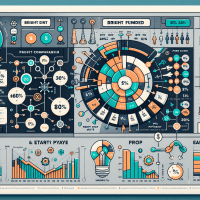Prop Trading Minimum Deposit: Proven Strategies for Funded Trader Success
For professional traders and aspiring funded traders, prop trading firms offer an enticing path to capital and success. With a focus on minimum deposit requirements, prop trading has opened up opportunities for those with lean budgets and a drive to prove their edge in the market. In this article, we explore actionable insights, effective risk management techniques, and deep dives into advanced backtesting tools that every prop trader should know.
Understanding Prop Trading and Its Minimum Deposit Model
Prop trading firms provide traders with the opportunity to trade the firm’s capital, thereby reducing personal financial exposure and offering a pathway to significant scaling. The minimal deposit requirement has attracted traders looking to minimize risk while maximizing the opportunity to leverage professional trading resources.
Many prop trading firms require only a low initial deposit, making them accessible to traders with varying levels of capital. These firms offer funded trader programs where performance, rather than capital investment, is key. By focusing on performance and risk management, firms tailor strategies to both retail and institutional traders.
Effective Backtesting Practices for Prop Trading
Backtesting is crucial for any prop trader to validate strategies before deploying them in a live trading environment. However, it is important to understand common pitfalls such as overfitting, survivorship bias, look-ahead bias, and data snooping. Here are key strategies to enhance your backtesting process:
- Walk-Forward Optimization: Unlike traditional backtesting, walk-forward optimization segments historical data into in-sample and out-of-sample sets, providing realistic performance metrics.
- Out-of-Sample Testing: Always reserve a segment of data to test out your strategy post-backtest, ensuring robust strategy performance under different market conditions.
- Forward Testing Integration: Complement your backtesting with simulated live trading (paper trading) to evaluate how the strategy adapts to real-time market conditions.

Figure 1: Screenshot of a backtesting report using NinjaTrader, showcasing key performance metrics like Sharpe Ratio and drawdown.
Top Automated Backtesting and Prop Trading Tools
For advanced prop traders, choosing the right backtesting tool is essential. Here, we compare and contrast some of the most popular platforms:
| Tool | Backtesting Features | Data Quality & Integration | Pricing | Prop Firm Use Cases |
|---|---|---|---|---|
| TradingView | Vectorized backtesting, script automation, and comprehensive charting | Access to extensive historical data, API integration with brokers, real-time feeds | Free tier available, premium plans start at competitive rates | Best suited for quick strategy prototyping and individual trader analysis |
| MetaTrader 5 | Event-driven backtesting, optimization capabilities, handling of commissions/slippage | Deep historical data across multiple asset classes, robust broker integration | Free demo, competitive account pricing | Ideal for both individual and firm-level use, robust for algorithmic trading |
| NinjaTrader | Comprehensive scenario analysis, automated report generation, stress testing | High-quality tick and bar data, extensive API options | Free simulation, licensing for live trading | Preferred by institutional prop trading teams for its scalability and team collaboration features |
| QuantConnect | Advanced parameter optimization, cloud-based backtesting on large datasets | Broad asset class support, strong API integration, live algorithm deployment | Free community access, premium tiers available | Excellent choice for quantitative strategies and multi-asset prop firms |
These platforms provide automated backtesting features that go beyond simple historical analysis. They allow for automated parameter optimization, sophisticated report generation, and built-in stress testing features ensuring that prop trading strategies are both robust and scalable.
Practical Case Studies from Leading Prop Trading Firms
Case Study 1: Implementing Walk-Forward Analysis
A mid-sized prop trading firm tested a new mean-reversion strategy using NinjaTrader. Their main challenge was overfitting the model to historical data. By implementing walk-forward optimization and out-of-sample testing, they observed a 15% improvement in their Sharpe Ratio and a 10% decrease in maximum drawdown over a 6-month simulation period. This allowed them to confidently deploy the strategy into live markets with automated risk management safeguards.
Case Study 2: Real-Time Data Integration in MetaTrader 5
An institutional prop trading team integrated MetaTrader 5’s API with real-time market data feeds to monitor algorithmic performance. By combining automated backtesting with continuous forward testing, they were able to automate parameter adjustments. This reduced manual intervention by 40% and improved execution speed, allowing for rapid responses to market volatility.
Advanced Backtesting Concepts and Automation in Prop Trading
Leveraging automated backtesting in prop trading involves not only running simulations but also integrating multi-faceted automation systems:
- Automated Parameter Optimization: Use scripts in Python with Backtrader to iteratively test various parameter combinations. For example, a simple Python snippet using Backtrader can help automate testing of moving average crossover parameters:
import backtrader as bt
class MovingAverageStrategy(bt.Strategy):
params = (('short_period', 20), ('long_period', 50))
def __init__(self):
self.short_ma = bt.indicators.SimpleMovingAverage(self.data.close, period=self.p.short_period)
self.long_ma = bt.indicators.SimpleMovingAverage(self.data.close, period=self.p.long_period)
def next(self):
if self.short_ma > self.long_ma and not self.position:
self.buy()
elif self.short_ma < self.long_ma and self.position:
self.sell()
# Setup cerebro engine
cerebro = bt.Cerebro()
cerebro.addstrategy(MovingAverageStrategy)
# load data, set cash etc.
cerebro.run()
Such automation is crucial for rapid iteration and stress testing, ensuring backtested strategies remain robust and viable for live deployment. It is also important to regularly update your historical databases and review data quality to counter issues like missing data or corporate actions.

Figure 2: MetaTrader 5 Interface displaying real-time analysis and backtesting reports, crucial for live adjustments in prop trading.
Risk Management and Compliance in Prop Trading
In an environment where capital is leveraged, strict risk management strategies are paramount. Prop traders typically target a Sharpe Ratio above 1.5, maintain drawdowns below 15%, and often require profit factors above 1.8 to justify live trading deployment. Compliance with regulatory frameworks such as MiFID II, ESMA, and NFA rules is also essential. Tools like Trade Ideas and Quant Tower offer real-time compliance monitoring and alert features to keep prop trading strategies within regulatory limits.
Next Steps for Aspiring Prop Traders
Now that you have gained in-depth knowledge of advanced backtesting, tool comparisons, and risk management strategies, it's time to take action:
- Review our detailed Risk Management Checklist to ensure your strategy meets all compliance requirements.
- Explore our advanced Backtesting Guide for detailed step-by-step instructions.
- Join our upcoming webinar on deploying automated strategies in live prop trading environments.
By implementing these strategies, you will be better positioned to succeed in the competitive world of prop trading with minimal initial deposits, while leveraging technological advancements in automated backtesting and real-time risk management.
Conclusion
Prop trading with a minimum deposit is not just an entry point—it is an opportunity to prove your trading acumen, effectively manage risk, and harness cutting-edge tools to compete with larger funds. As of October 2023, the integration of automated backtesting, walk-forward optimization, and real-time compliance monitoring stands out as the optimal approach for both individual and institutional traders.
Pro Tip: Regularly update your trading algorithms and backtesting framework to adapt to changing market conditions. Continuous learning and technological adoption are the keys to sustained success in the prop trading arena.
For further insights and actionable strategies, subscribe to our newsletter and stay updated with the latest tools and regulatory changes affecting the prop trading sector.







